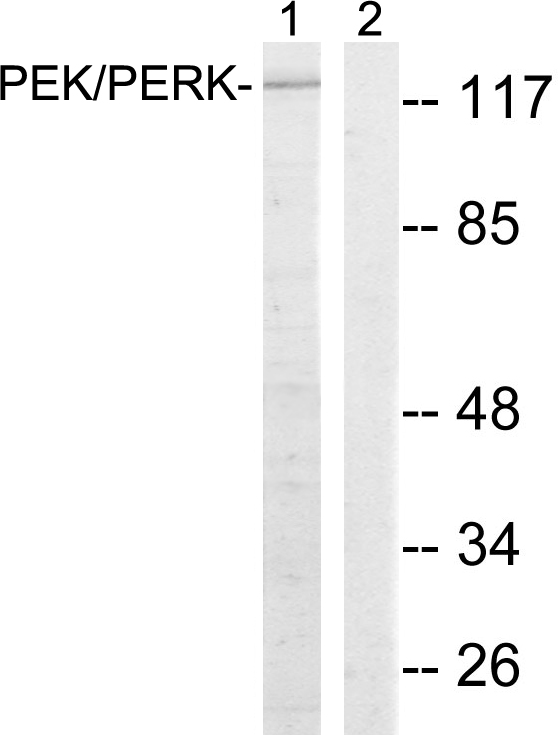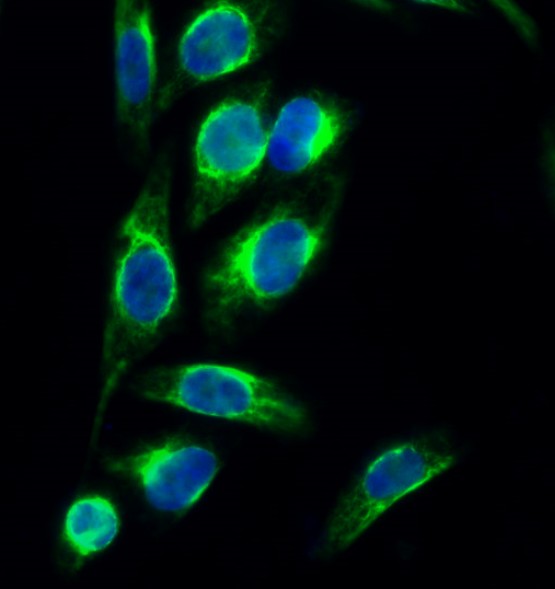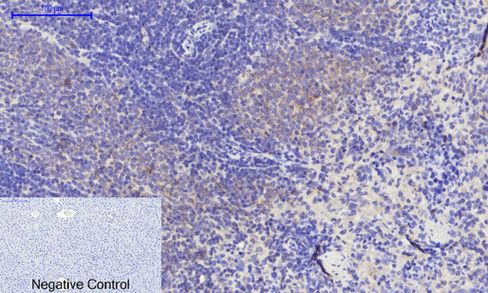


| WB | 咨询技术 | Human,Mouse,Rat |
| IF | 咨询技术 | Human,Mouse,Rat |
| IHC | 1/50-1/100 | Human,Mouse,Rat |
| ICC | 1/50-1/200 | Human,Mouse,Rat |
| FCM | 咨询技术 | Human,Mouse,Rat |
| Elisa | 1/10000 | Human,Mouse,Rat |
| Aliases | EIF2AK3; PEK; PERK; Eukaryotic translation initiation factor 2-alpha kinase 3; PRKR-like endoplasmic reticulum kinase; Pancreatic eIF2-alpha kinase; HsPEK |
| Entrez GeneID | 9451 |
| WB Predicted band size | Calculated MW: 125 kDa; Observed MW: 125 kDa |
| Host/Isotype | Rabbit IgG |
| Antibody Type | Primary antibody |
| Storage | Store at 4°C short term. Aliquot and store at -20°C long term. Avoid freeze/thaw cycles. |
| Species Reactivity | Human,Mouse,Rat |
| Immunogen | The antiserum was produced against synthesized peptide derived from human EIF2AK3. AA range:947-996 |
| Formulation | Purified antibody in PBS with 0.05% sodium azide,0.5%BSA and 50% glycerol. |
+ +
以下是3篇与PERK抗体相关的文献及其摘要概述:
1. **"Protein translation and folding are coupled by an endoplasmic-reticulum-resident kinase"**
- **作者**: Harding, H.P., et al. (2000)
- **摘要**: 该研究首次阐明了PERK(PKR-like ER kinase)作为内质网应激传感器的作用。通过使用特异性PERK抗体,研究者发现PERK通过磷酸化eIF2α来抑制蛋白质翻译,缓解内质网中未折叠蛋白的累积,揭示了PERK在细胞应激响应中的关键调控机制。
2. **"ER stress contributes to autophagy induction by the PERK-eIF2α pathway in cancer cells"**
- **作者**: Rouschop, K.M., et al. (2013)
- **摘要**: 本文利用PERK抗体研究PERK信号通路在肿瘤细胞自噬中的作用。实验表明,内质网应激通过激活PERK-eIF2α轴诱导自噬,帮助肿瘤细胞在缺氧或营养缺乏条件下存活,为靶向PERK的癌症治疗提供了理论基础。
3. **"The unfolded protein response in neurodegenerative diseases: PERK perspectives"**
- **作者**: Hetz, C., et al. (2013)
- **摘要**: 该综述总结了PERK在阿尔茨海默病、帕金森病等神经退行性疾病中的研究进展。通过免疫印迹和免疫组化(使用PERK抗体),研究显示PERK信号异常与神经元内蛋白错误折叠和细胞死亡密切相关,提示其作为潜在治疗靶点的可能性。
4. **"Pharmacological targeting of PERK in retinal neurodegeneration"**
- **作者**: Oshitari, T., et al. (2021)
- **摘要**: 研究者通过PERK抗体检测糖尿病视网膜病变模型中PERK的激活状态,发现抑制PERK可减少视网膜神经节细胞凋亡,表明调控PERK通路可能成为治疗糖尿病相关神经退行性病变的新策略。
以上文献均涉及PERK抗体的实验应用(如Western blot、免疫组化),并聚焦于PERK在内质网应激、疾病机制及治疗中的功能。
PERK (Protein kinase R-like endoplasmic reticulum kinase), also known as eukaryotic translation initiation factor 2-alpha kinase 3 (EIF2AK3), is a key sensor in the unfolded protein response (UPR) pathway. It is activated during endoplasmic reticulum (ER) stress, a condition caused by the accumulation of misfolded or unfolded proteins in the ER lumen. PERK is a transmembrane protein with an ER-luminal stress-sensing domain and a cytoplasmic kinase domain. Upon ER stress, PERK dimerizes and autophosphorylates, initiating downstream signaling to restore cellular homeostasis. Its primary role involves phosphorylating eukaryotic initiation factor 2α (eIF2α), which transiently inhibits global protein translation while selectively promoting the expression of stress-responsive genes, such as ATF4. to enhance protein-folding capacity or trigger apoptosis if stress persists.
PERK antibodies are essential tools for studying ER stress mechanisms in diseases like neurodegeneration, cancer, and diabetes. These antibodies enable detection of PERK expression, phosphorylation status (e.g., Thr980/Thr981 in humans), and interactions with other UPR components. Commercial PERK antibodies are validated for techniques including Western blotting, immunofluorescence, and immunoprecipitation. Dysregulation of PERK signaling has been linked to Alzheimer’s, Parkinson’s, and multiple myeloma, making its study critical for therapeutic targeting. Researchers rely on high-specificity PERK antibodies to dissect its dual role in promoting cell survival under mild stress or apoptosis under chronic stress, offering insights into disease pathology and treatment strategies.
×